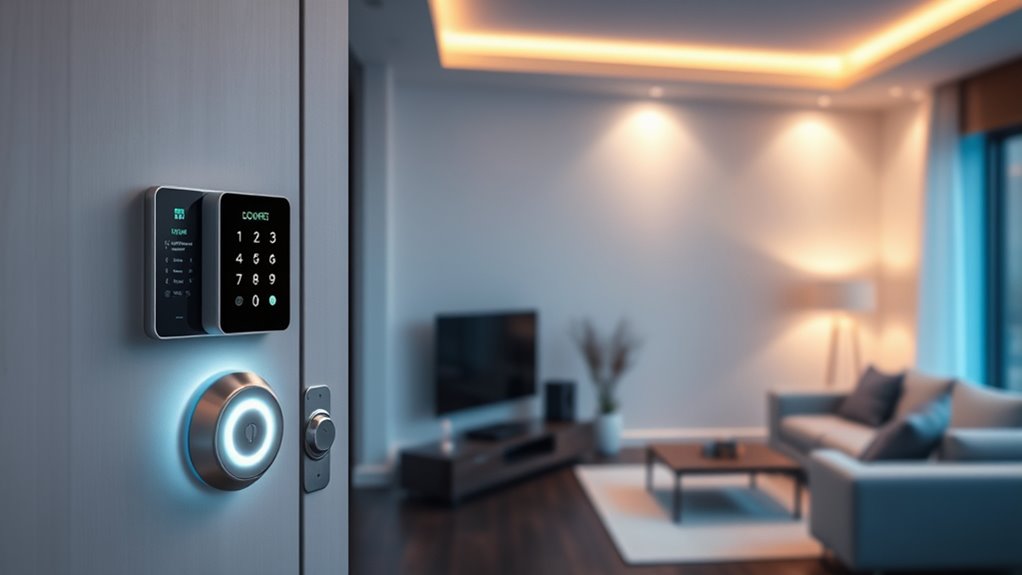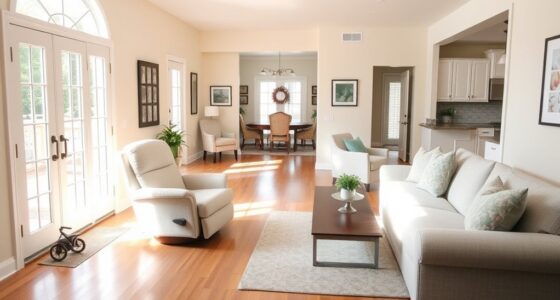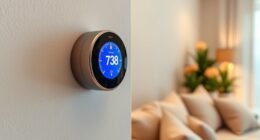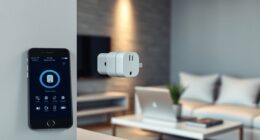Using home automation for security and safety allows you to monitor your property remotely with live camera feeds, control locks, and receive real-time alerts for smoke, CO, or break-ins. You can quickly verify situations, contact emergency services, or open doors for responders—all from anywhere. This creates a responsive, peace-of-mind system that keeps your home safe and gives you confidence in its protection. Exploring this further reveals how to tailor these features to suit your needs perfectly.
Key Takeaways
- Enable remote access to live camera feeds, doorbell footage, and control locks for constant property visibility.
- Receive immediate alerts for smoke, CO, or break-ins, allowing quick responses to emergencies.
- Verify security events remotely and activate emergency protocols, including calling services or unlocking doors.
- Set customized notifications for unusual activity, ensuring prompt awareness of potential threats.
- Integrate system features to create a responsive, smart home that enhances safety and peace of mind.
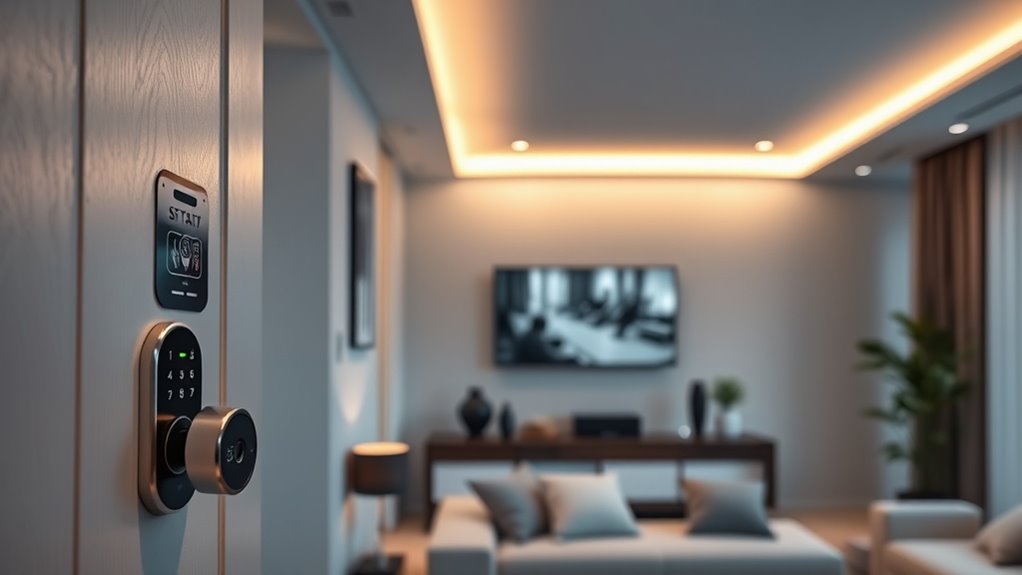
Home automation has revolutionized how you protect your home, making security and safety more accessible and effective than ever before. With smart devices connected through your home network, you can keep an eye on your property no matter where you are. Remote monitoring allows you to check live feeds from security cameras, view doorbell camera footage, or even control locks and alarms remotely. This means you’re not limited to being physically present to guarantee your home’s safety. Whether you’re at work, on vacation, or simply away for the day, you can quickly verify who’s at your door, see if any unusual activity is happening, and respond accordingly. This constant visibility enhances your ability to respond swiftly to potential threats or emergencies.
Emergency alerts are another powerful feature of modern home automation systems. When connected sensors detect smoke, carbon monoxide, or even a break-in, your system can send immediate alerts to your phone or email. These alerts enable you to act quickly, whether that means calling emergency services, opening locks for first responders, or simply checking your live feed to assess the situation. Some systems even integrate with local emergency services, automatically notifying authorities if certain thresholds are met. This rapid communication can drastically reduce response times, minimizing damage or danger. Plus, many smart systems allow you to customize alerts based on specific triggers, so you’re only notified about what matters most to you.
The convenience of remote monitoring combined with real-time emergency alerts means you’re constantly in control of your home’s security, no matter where life takes you. You don’t need to worry about missing critical events or being caught off guard. Instead, your system acts as a vigilant, always-on security partner. You can set up notifications for various scenarios, such as a door opening at unusual hours or a window breaking. These alerts empower you to take immediate action, whether that’s calling the police, alerting neighbors, or simply locking a door remotely. They also provide peace of mind, knowing that help can be on the way even if you’re miles away.
In essence, home automation transforms your home into a smart, responsive fortress. Remote monitoring keeps you connected and aware, while emergency alerts ensure you’re instantly notified of potential dangers. These features work together to create a safer environment, allowing you to protect your home and loved ones more effectively than traditional security measures ever could. Additionally, understanding home automation security features can help you choose systems that best meet your safety needs.
Frequently Asked Questions
Can Home Automation Systems Be Hacked Remotely?
Yes, home automation systems can be hacked remotely if cybersecurity vulnerabilities aren’t addressed. Hackers often exploit weak passwords or outdated software, so it’s vital you use strong, unique passwords. Make sure your system employs robust encryption protocols to protect your data. Regularly update firmware and security settings, and avoid connecting devices to unsecured networks. Staying vigilant helps prevent unauthorized access and keeps your home safe.
How Much Does Installing a Home Automation Security System Cost?
Installation costs for a home automation security system vary based on features and size. You might spend between $500 to $2,500, including equipment and professional setup. To stay within your budget, plan carefully and compare options. Consider DIY installation if you’re comfortable, as it can reduce costs. Remember, investing in quality security adds peace of mind, so balance your budget planning with the level of safety you desire.
Are There Legal Restrictions on Monitoring Outdoor Areas?
You need to guarantee legal compliance and respect privacy considerations when monitoring outdoor areas. Laws vary by location, so you should check local regulations about surveillance, sound recording, and property boundaries. Avoid capturing images or audio of neighbors or public spaces without consent. Always inform visitors about monitoring systems, and position cameras to focus only on your property. Staying informed and respectful helps you avoid legal issues and maintains good community relations.
What Is the Typical Lifespan of Home Automation Security Devices?
Most home automation security devices last around 3 to 5 years, but their lifespan depends on device durability and your maintenance schedule. Regularly updating firmware, cleaning sensors, and replacing batteries can extend their life. Keep an eye on signs of wear or malfunction, and follow the manufacturer’s maintenance recommendations. Proper care guarantees your security devices stay functioning effectively, giving you peace of mind for years to come.
How Do I Ensure My Data Privacy With Smart Security Devices?
To guarantee your data privacy with smart security devices, you should enable data encryption on all devices and networks. Regularly update firmware to patch security vulnerabilities. Control user access by setting strong, unique passwords and limiting user permissions. Additionally, review privacy settings frequently and disable features you don’t use. By actively managing data encryption and user access, you protect your sensitive information from potential breaches and unauthorized access.
Conclusion
By blending bold, brilliant home automation solutions, you boost your safety and secure your sanctuary. Embrace innovative integrations that instantly alert you to intruders, fires, or leaks, ensuring you’re always a step ahead. With smart security systems, you’re not just safeguarding your space—you’re strengthening your sense of safety. So, take charge, tap into technology, and transform your home into a secure, safe sanctuary where peace of mind is always within reach.
